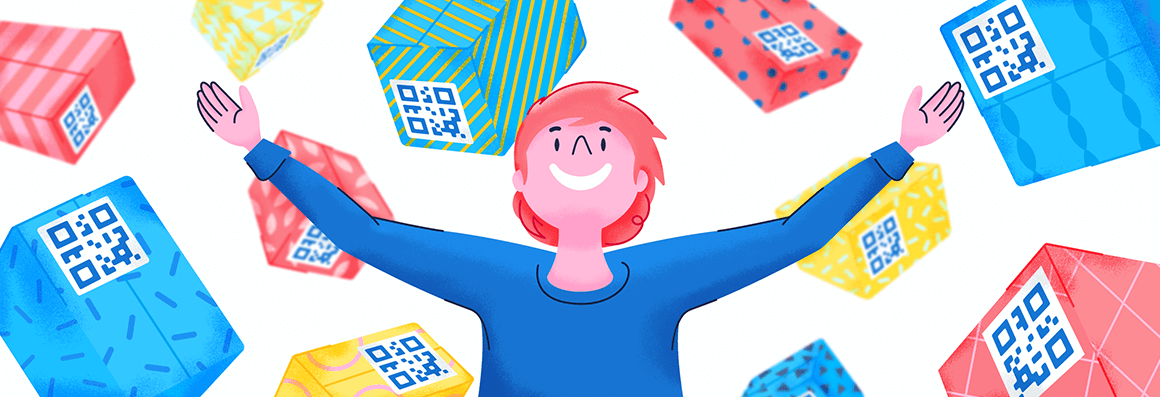- Best Practices ●
- COVID-19 ●
- Industry Trends ●
- Partners ●
- Product ●
The Beginner’s Guide to QR Code Inventory Management
Inventory management can be daunting, especially if you rely on manual logging. Human error in manual data entry can lead to inaccurate records, unexpected stockouts, or costly overstocking.
While traditional one-dimensional barcodes are a step up from manual processes, they have limitations—they’re prone to scanning errors and can store only a small amount of data.
That’s why many modern businesses are embracing QR Codes for asset management. These versatile tools have transformed inventory management processes by enabling faster counts, real-time traceability, and fewer logging errors.
In this guide, we’ll explore the benefits of QR Codes in manufacturing and inventory management and share practical tips for creating and implementing them effectively.
Note: The brands and examples discussed below were found during our online research for this article.
QR Codes vs Barcodes: Key differences and why they matter
When it comes to QR Codes vs. barcodes, QR Codes are more effective for modern inventory management. These pixelated tools have become essential for manufacturers and business owners looking to streamline their operations. They offer several advantages over traditional barcodes, including:
- Increased data capacity: Quick Response (QR) Codes can store 4,296 alphanumeric characters, 1,817 Kanji characters, or 7,089 numeric characters, while 1D barcodes have a 20-character limit.
- Omnidirectional scanning: These codes can be scanned from any direction, making inventory item counts faster and more efficient.
- Smartphone compatibility: No special hardware is required—nearly all smartphone cameras can scan QR Codes.
- Error correction capabilities: Built-in error correction means QR Codes remain scannable even when damaged.
Static and Dynamic Codes are the two main types of QR Codes. Dynamic Codes are often the superior choice for inventory management because they’re editable even after printing and offer scan analytics. Static QR Codes, however, can still be useful for tracking inventory data like product names, qualities, and expiration dates.
For maximum control and flexibility, Dynamic QR Codes are the better option. For instance, if you want to use QR Codes for toy manufacturing, you could use Dynamic Codes to direct users to databases with details like SKUs during supply chain movements. Later, you can update their destinations to link to assembly tutorials once the toys reach retail shelves.
The benefits of using QR Codes for inventory management
Modern global manufacturing and logistics systems are more complex than they used to be. QR Codes can hold much more comprehensive information, making them well-suited for these advanced systems. Let’s take a closer look at why you should use QR Codes for inventory management.
Eliminating old-school scanning devices
Let’s be honest—while effective, barcode scanners can be bulky and expensive, especially for businesses managing large inventories. Further, to use traditional scanning devices, they must be connected to a computer, or you need to have one nearby, which isn’t always practical.
Busy distribution centers often handle product inventory in a bustling loading dock or warehouse where computers may not be conveniently located. This can make asset tracking and management challenging.
QR Codes eliminate the need for dedicated scanners. While you can still use them, most mobile devices can effectively scan QR Codes, allowing asset management teams to track inventory using just their smartphones.
Asset tracking in real time
QR Codes facilitate real-time asset tracking by providing information like location, scan time, and even devices used. Tracking QR Code scans can help you monitor product movement in national or global operations by providing country- and city-level data. If items are misplaced, you can identify the last scanned location or time, simplifying follow-ups.
For detailed inventory tracking, use QR Code Generator PRO alongside other inventory management tools. QR Code Generator PRO can help you track the number, location, and time of scans, while your preferred management software can monitor stock levels.
Displaying additional information
As mentioned earlier, QR Codes have a much higher capacity than traditional barcodes, allowing for more detailed information storage. But they also support multiple data types. QR Code Generator PRO offers a variety of QR Code solutions for product inventory management, such as:
- PDF QR Codes for manuals
- Image Gallery QR Codes for product images (especially useful for boxes containing multiple items)
- Video QR Codes for explaining product usage
- Business Page QR Codes for identifying transportation boxes (perfect for warehouses handling products from multiple companies)
Preventing and correcting errors
QR Codes help reduce errors in inventory management by minimizing manual data entry. When integrated with your inventory management software, they allow for real-time product updates in your system, eliminating the need for manual logging.
These versatile tools also offer a higher error correction rate than barcodes—up to 30% error tolerance—thanks to their square-shaped elements that are grouped in duplicates. This design allows QR Codes to remain scannable even when exposed to challenging transportation and weather conditions, such as extreme temperatures, rain, and wind.
With Dynamic QR Codes, you can easily edit and update linked resources in the event of errors or new versions. You can also modify the linked destination without reprinting your code. For example, you could change from a PDF QR Code to an Image Gallery QR Code without altering the printed version.
Customizing for different types of products
Modern QR Codes no longer need to be black and white. You can customize your codes with different colors, unique QR Code frames, and even a business logo.
This flexibility is particularly useful for distinguishing products moving between different companies. Customized codes help warehouse staff quickly label and organize boxes before scanning them.
Integrating with your existing inventory management system
Most inventory management tools already support 2D barcodes, so there’s no need to invest in new software when adopting QR Code technology.
Simply find a reliable generator, confirm your system can handle QR Code scanning, and you’re good to go. QR Code Generator PRO is an excellent starting point, offering a free trial with the option to upgrade. This allows you to generate codes and test their compatibility with your existing systems before committing to a paid plan.
How to create and implement QR Codes for inventory management
QR Codes can make an immediate impact on your inventory management workflow. Fortunately, creating and implementing them is easy, allowing you to streamline your processes quickly. Here’s how to get started:
1. Use a reliable QR Code generator
The first step is choosing software that generates QR Codes effectively. While there are many options, not all make the process intuitive. Prioritize user-friendly tools to minimize the learning curve and help you implement the solution quickly.
QR Code Generator PRO lets you create QR Codes in just three simple steps:
- Choose the type of information you want your codes to display.
- Enter the information in the required fields.
- Download your QR Codes.
Consider the type of QR Codes a generator offers before making your selection. If you need the flexibility to update codes after printing, ensure the tool supports Dynamic QR Codes.
2. Create QR Codes for products
Creating QR Codes using QR Code Generator PRO is straightforward:
- Log in to your account.
- Select the type of code you need, such as a Video Code or a URL Code.
- Fill in the required fields based on your chosen QR Code type.
- Select Next after entering all the required details.
- Customize your code by selecting a unique frame and colors that align with your business. You can even add your logo if you have a paid plan. Alternatively, you can stick to the classic black-and-white design.
- Once you’re satisfied with your design, select Download.
3. Label and attach QR Codes
If you’ve created different codes for multiple products, create QR Code labels to identify clearly where each one belongs. Once your labels are ready, print and attach them to your products.
People can scan QR Codes from any direction, so you can place them wherever they’re most likely to be scanned without worrying about the angle. However, ensure your labels are an appropriate size for your packaging for optimal scannability.
4. Integrate with inventory management software
Many inventory management systems already support QR Codes, so integration should be straightforward.
If your system has an application programming interface (API), work with your IT team to link your software with barcode scanners or smartphones. This connection can streamline the flow of information between your scanning devices and inventory software.
5. Train staff
This solution will only improve your inventory management if your staff knows how to scan QR Codes and use your tracking system. The good news is that scanning QR Codes is simple and requires minimal training for basic tasks.
However, consider training your team members to analyze metrics, such as scan counts, and compare them to data from other inventory management tools for increased accuracy.
3 Other top use cases for QR Codes
The beauty of QR Codes lies in their versatility—they’re useful for far more than just inventory management. Businesses across industries can leverage them to streamline operations, enhance customer experiences, and promote brand transparency.
Here are three impactful ways to use QR Codes beyond inventory management:
1. Enhance product marketing with smart packaging
Manufacturers, CPG brands, and retailers can use QR Codes on smart packaging to increase customer engagement and gain valuable insights about their target audiences. These codes can link to valuable resources that help businesses connect with their customers, such as:
- Social Media QR Codes: Direct customers to your social media channels to boost brand interaction.
- Feedback QR Codes: Collect customer opinions and use that information to improve product quality.
- PDF QR Codes: Share detailed product information, including allergen details and raw materials used.
You can also simplify product registration with QR Codes by linking them to warranty pages, allowing customers to scan and complete registration online—no manual forms required.
Learn more about how smart packaging QR Codes can elevate your products!
2. Maintain smooth operations with better maintenance management
For manufacturers, keeping equipment in top condition is crucial for long-term efficiency and cost control. QR Codes can help by streamlining the maintenance process. They can link to details like proper machine use, cleaning, and repair, ensuring your staff takes appropriate care of your equipment.
You can also use QR Codes to track warranty periods by linking them to digital warranty records and equipment maintenance histories. This allows your team to stay on top of service schedules and perform necessary maintenance tasks more efficiently.
3. Improve the customer experience with easy-to-follow user manuals
QR Codes can transform how customers interact with your products by making user manuals more accessible and engaging. Rather than flipping through bulky paper manuals, customers can scan a code to access:
- Digital instruction guides for faster setup and troubleshooting.
- Video tutorials for visual step-by-step assistance.
- Audio guides for hands-free support.
This not only improves the user experience but also adds value to your products by making support easier to find and use.
Learn how to use QR Codes on instruction manuals to better serve your customers.
Speed up your inventory process with QR Code Generator PRO
QR Codes are indispensable tools in modern inventory management. They provide access to critical product details like SKUs while enhancing asset visibility for more efficient inventory control. But they can also go beyond the warehouse, supporting customer engagement, improving equipment maintenance, and enhancing post-purchase support.
QR Code Generator PRO makes it easy to streamline your inventory processes with a wide range of QR Codes you can tailor to your business needs. Whether you want to simplify asset tracking, improve supply chain efficiency, or just keep your inventory data organized and up to date, QR Codes are the perfect solution.
Get started with QR Code Generator PRO to streamline your inventory process and empower your team with smarter asset management tools.






 Add custom colors, logos and frames.
Add custom colors, logos and frames.
